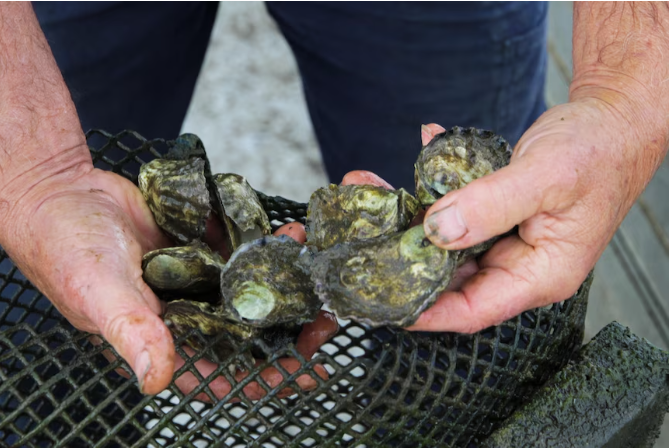Wet storage tanks a popular choice for NSW South Coast oyster farmers seeking weather protection
Oyster farmer Kevin McAsh is an early adopter of wet storage tanks in NSW.(ABC South East NSW: James Tugwell)
When South Coast oyster farmers were unable to harvest after record-breaking rainfall resulted in estuary closures early December, Kevin McAsh could keep selling because of his decision to install wet storage tanks.
Key points:
Oyster farmers in NSW have struggled for three years because of environmental factors
Wet storage tanks allow oysters to be stored, increasing productivity and allowing harvest during weather events
Industry guidelines will be rolled out across the state along with training sessions
Wet storage tanks allow oysters to be stored in the short term while maintaining their freshness and quality.
Mr McAsh was an early adopter of the tanks, which have become increasingly popular among NSW oyster farmers as environmental events disrupt business.
"The last three years have been a bit hectic," he said.
He desperately fought to save the infrastructure at his lease on the Bhundoo/Clyde River during the Black Summer bushfires.
The island where Mr McAsh sorts and grades oysters was negatively impacted, while the banks of the river were "decimated in places".
The Clyde River at Batemans Bay produces more than 42,000 dozen Sydney rock oysters annually.(ABC South East NSW: James Tugwell)
It was only the beginning of the troubles NSW South Coast oyster farmers would face.
Oysters are heavily monitored for food safety by the NSW Department of Primary Industries (DPI) and can only be harvested when water conditions fall into a specific salinity window.
Wet La Niña weather after Black Summer caused the river to be closed for short periods on and off, and for an extended period of three months.
This was followed by a tsunami warning and the COVID-19-enforced closure of restaurants and tourism.
"It brought the industry to its knees," Mr McAsh said.
Mr McAsh looked at the effect weather conditions were having on his lease and decided to install wet storage tanks to store oysters on land.
He sees the tanks as a way forward for the state's $35-million-a-year industry.
Mr McAsh said the tanks should play a key role in steering the oyster industry forward.(ABC South East NSW: James Tugwell)
Insurance against river closures
Traditionally, oysters are not stored on land but in the water on the lease, where they are susceptible to weather events.
A wet storage tank stores oysters in salt water at 12 degrees Celsius, which slows their metabolism and allows them to be stored for weeks while maintaining freshness, creating an insurance buffer from weather events.
The wet storage tanks reduce the oyster's metabolic activity, allowing them to be stored for weeks.(ABC South East NSW: James Tugwell)
Mr McAsh has four tanks, which cost about $40,000 each and can hold a total of 4,000-dozen oysters.
"It allows us to harvest and hold these oysters and it cushions the effects of adverse climate conditions. It's a risk management strategy," Mr McAsh said.
Mr McAsh said heavy rain could close the river for weeks but, with prior warning, he could transfer oysters into the wet storage tanks.
Mr McAsh says storage tanks make his business more efficient and provide a level of protection.(ABC South East NSW: James Tugwell)
"We can continue to market our oysters until the river reopens," he said. "We can maintain consistent, quality supply."
Addressing biosecurity concerns
DPI aquaculture program leader Ian Lyall said interest in wet storage tanks had increased significantly among oyster farmers because of the difficulties faced during the wet La Niña period.
Ian Lyall says it's important to ensure the tanks meet food safety and aquatic biosecurity standards.(Supplied: Department of Primary Industries)
"It's been taken up with gusto by the industry," he said.
Mr Lyall said storing oysters in tanks where their run-off goes into estuaries was a potential risk to biosecurity and could spread disease between oysters.
A joint industry and government shellfish committee has created guidelines for farmers, which will be rolled out across the state, while the NSW Food Authority will offer industry training on the systems in 2024.
Sydney rock oysters account for more than 90 per cent of oyster production in New South Wales.(ABC South East NSW: James Tugwell)
Mr Lyall said wet storage tanks could be used by seafood retailers and wholesalers, creating a new retail experience where customers could choose their oyster and eat it fresh from the water.
"Wet storage will just be part of an oyster farmer's tool box where they can use it to their advantage," he said. "There are so many positives."
Mr Lyall says the oyster industry will need to increase production if it wants to export.(ABC South East NSW: James Tugwell)
The world is your oyster
Typically, Mr McAsh would have to travel by boat to the lease and harvest oysters from the water for every purchase, taking up time and resources.
Wet storage tanks reduce the number of times oyster farmers have to travel to the leases.(ABC South East NSW: James Tugwell)
With wet storage tanks, he can harvest and grade oysters in bulk, storing them ready for immediate sale from the tank.
He hopes greater uptake in the industry will boost domestic production and see Sydney rock oysters take on the world stage.
They are currently not exported in large quantities, with producers unable to meet demand in the domestic market.
"We want to increase production," Mr McAsh said. "We hope to get export approval and then we'll explore export opportunities."
Mr McAsh's wet storage tanks allow him to hold 4,000 dozen oysters graded and ready for sale.(ABC South East NSW: James Tugwell)
Read more: Click here











